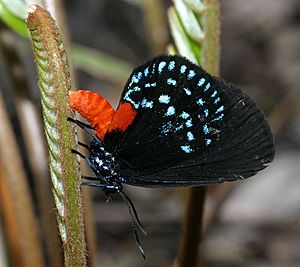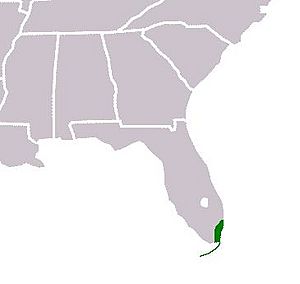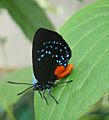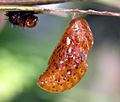Atala facts for kids
Quick facts for kids Atala |
|
|---|---|
 |
|
| Scientific classification | |
| Kingdom: | |
| Phylum: | |
| Class: | |
| Order: | |
| Family: | |
| Genus: |
Eumaeus
|
| Species: |
E. atala
|
| Binomial name | |
| Eumaeus atala (Poey, 1832)
|
|
 |
|
| Range in Florida (also found in the Bahamas and Cuba) | |
The Atala butterfly, also called the coontie hairstreak, is a small and very colorful butterfly. It belongs to the family Lycaenidae. You can find this butterfly in southeastern Florida, the Bahamas, Cuba, and the Cayman Islands. It might also live on other Caribbean islands. The Atala butterfly is special because of its bright colors and unique habits.
Contents
Warning Colors of the Atala Butterfly
The Atala butterfly uses bright colors to warn predators. This is called aposematic coloration. You can see these warning colors at every stage of its life.
Toxic Food and Protection
The Atala caterpillar eats special plants called cycads. These plants have a toxic chemical called cycasin. The caterpillar keeps this chemical in its body. This makes the caterpillar, pupa, and adult butterfly taste bad to animals. Birds, lizards, and other predators quickly learn to avoid these brightly colored insects.
In Florida, the caterpillars mostly eat a native cycad called Zamia pumila. This plant is also known as coontie or arrowhead. They also eat cycads that people plant in their gardens. In Cuba, they eat a cycad called Cycas revoluta.
Life and Habits of the Atala
Adult Atala butterflies drink nectar from flowers. They sometimes rest in trees. You can see them flying for most of the year.
Where Atalas Live
Atala butterflies live in open, brushy areas. They also like subtropical hammocks, which are often found in pine forests. Today, many Atala butterflies live in suburban areas. This is because people plant ornamental cycads there.
Flight and Courtship
Atala butterflies usually stay close to where their host plants grow. This means they form small groups or colonies. However, female butterflies might fly further away to find more plants for their eggs. The Atala butterfly flies slowly. This is different from many other butterflies in its family, which fly very fast.
Male Atala butterflies have special hairs on their bodies called hair-pencils. They use these to release special scents called pheromones. During courtship, the male hovers in front of the female. He waves these scents towards her.
Eggs and Young
Female Atalas lay their eggs in clusters. Each cluster has about 10 to 50 eggs. They lay these eggs on the tips of the host plant leaves. The young caterpillars then eat the leaves. When it's time to change into a butterfly, the pupa usually stays on the host plant.
Return of the Atala Butterfly
The Atala butterfly has a subspecies in Florida called Eumaeus atala florida. People once thought this butterfly had disappeared. This was because too many coontie plants, its main food, were harvested. From 1937 to 1959, no Atala butterflies were seen in Florida.
However, the Atala butterfly is now common in some parts of southeast Florida. It has made a comeback! This is partly because it started eating ornamental cycads. These are the cycad plants that people plant in their gardens in suburban areas. For example, in Palm Springs, Florida, the G-Star School of the Arts has helped the subspecies grow again.
Naming the Atala Butterfly
The Atala butterfly was first described by a Cuban zoologist named Felipe Poey. He named the butterfly after Atala. Atala was a Native American heroine in a French story from 1801. The story was called Atala, or The Loves of Two Savages in the Desert. It was written by Chateaubriand.
Gallery
See also
 In Spanish: Atala para niños
In Spanish: Atala para niños




